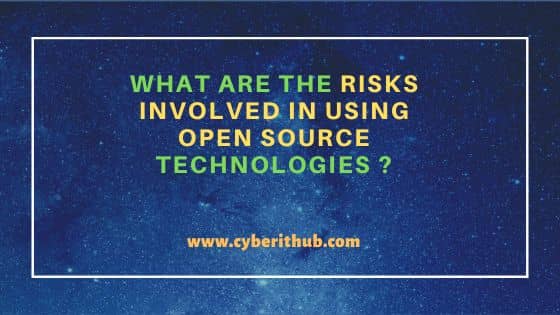Table of Contents
With the onset of Digital Era, there is an increase uptrend in using more and more open source technologies by the Information Technologies Organizations across the globe to optimize the Budget Costs and customize the applications as per organizational requirements. But with the increased usage there is an inherent security risks and challenges involved which often get ignored by the major IT organization hence creating high risk vulnerabilities. This reduces the quality of application developed and makes it prone for external attacks.
What is Open Source Technology
Any application, software or code which is freely and publicly available for enhancement and usage under open source license are known as open source technologies. These technologies are generally maintained by an open source community in code version like GitHub.

What are the Risks Involved in using Open Source Technologies ?
Also Read: Blockchains Vs Databases - Understanding the Difference and Usage
1. Risk of using outdated components
Since open source components are generally managed by a public community, there is no timeline of getting it updated regularly. One can raise a request for updating the core components and libraries but there is no way to get those on time. One has to wait for the latest updates to be released for general use.
2. Increase in Code Vulnerability
Open source applications or codes carries many potential risk which makes it vulnerable to the external challenges. In the sixth Open Source Security and Risk Analysis (OSSRA) report, it has been observed that almost 84% of codebases contain an open source vulnerability. Attackers can easily identify this vulnerability and launch attacks to damage the code infrastructure.
3. Risk of using Unlicensed Software
The usage of unlicensed software can lead to many disabilities and unwarranted impact on the System. It has been observed that system does not get well along with unlicensed applications. There is a great chance of violation of copyright law in using unlicensed software.
4. Lack of Support and Accountability
Support and Accountability are one of the biggest challenges involved in using open source applications. It comes with no legal support terms and no one is accountable for any kind of issues and risks. Users using the open source applications has to rely on themselves for fixing any issues that arises during its usage.
5. Intellectual Property Right Issues
Statistically, it has been observed that there are lot of intellectual property right issues are arising in using open source applications. In one of the Cisco vs Free Software Foundation case, cisco was found to be using source codes based on Open Source Software Licenses released by Free Software Foundation, without any compliance of any terms and conditions. This led Free Software Foundation to take a legal action against Cisco for Infringement of Intellectual Property Rights. Similarly, there are many such cases coming into light that needs to be addressed.
6. Increase Security Risk
With more and more external attacks increasing everyday, security is a big risk in using open source application. Generally, an open source codes and applications are not well tested for any security risk. It is upon the user to understand the security risk before using any of the open source code. If you raise an issue, then there is no guarantee of getting security fixes and bug fixes on time to deal with this incredible challenge.
7. Risk in Sustainability
Sustainability is another significant risk in using an open source application. To make an open source application sustainable, it requires constant funding with reliable support. There are not many organizations out there ready to fund the open source projects. Hence there is a great risk that an open source application might work today and suddenly stops working from tomorrow.
8. Integration Challenges
Integrating an open source application with a licensed product can sometime be a big challenge to deal with. Usually a License product works smoothly with trusted software and applications but does not give the same guarantee with open source applications. If the application itself does not give any guideline of using it with some other product then it will be entirely upon the user to plan the integration and test if it serves the purpose.
